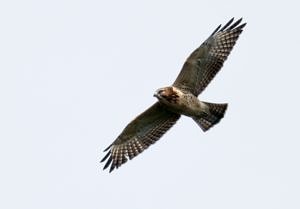The View from Pack: Raptor Migration 2022
You can find annual summaries of Pack Monadnock migration data from recent years here. Detailed historic data — including hourly raptor count and weather data, non-raptor observations, special notes, and season totals — are also posted on hawkcount.org, an online database managed by the Hawk Migration Association of North America (HMANA). Read on for “field reports” from the 2022 season, as shared by Hawk Watch Coordinator Phil Brown.
Highlights from the 2022 Season
Season Summary 2022

Celebrating our 10,000th raptor with Daniel Lampe, Katrina Fenton, and Levi Burford (left to right). (photo © Levi Burford)
The fall 2022 season — our 18th consecutive year — of the Pack Monadnock Raptor Observatory was a resounding success! Our effort and hours were consistent, our visitors were numerous and happy, and folks got to experience quite a bit of migration. The 10,000th migrant raptor of the season was observed on September 25th, an appropriate date for an “average” year.
Species Trends
Below is a brief species-by-species summary of the 2022 season:
– Black Vulture – 1 – Last year we counted our first two Black Vultures in the official history of the count. We’ll see if this becomes an annual occurrence as we had predicted more than a decade ago.
– Turkey Vulture – 493 – this comes in at the second highest season total in the history of our project and continues the trend of increasing numbers generally.
– Osprey – 137 – this year’s total is the lowest year since the beginning of the count in 2005. The suspicion is that the steady increase in Bald Eagle numbers has something to do with the steady decrease in Osprey numbers. Bald Eagles tend to outcompete Ospreys for territory space, predate the young, and steal the Osprey’s fish.
– Bald Eagle – 2210 – this is the first time in the last decade that the Observatory did not set a season total record for migrant Bald Eagles. This could be due to a mild November, and a suspicion that some migrated after November 20.
– Northern Harrier – 84 – an average tally. Our observers aged this species too, tallying 77% as juveniles (higher than last year’s 64% by a significant margin).
– Sharp-shinned Hawk – 886 – a low year for “Sharpies.” We suspect that we missed a lot of Sharp-shinned Hawks that flew below the observation height of the Observatory due to strong winds.
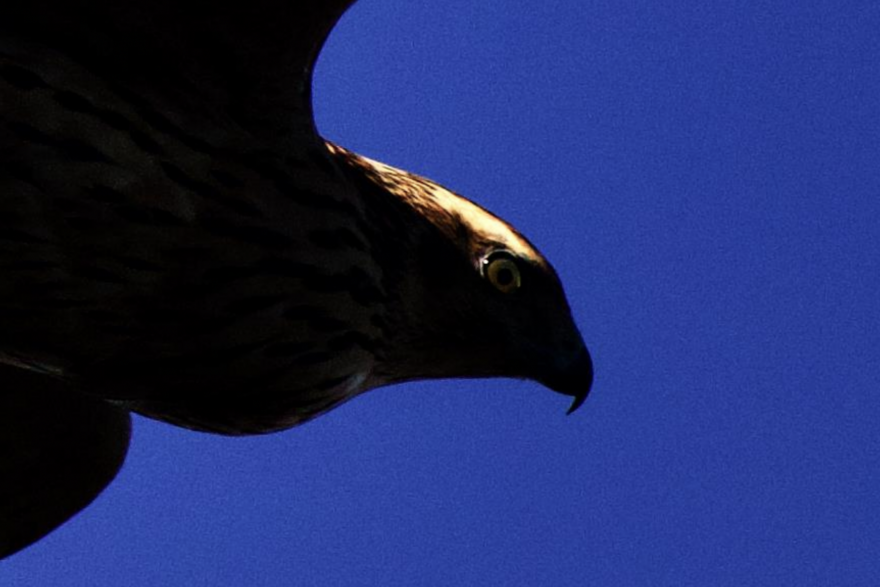
The striking eye-striped of a juvenile Northern Goshawk. The full crop indicates a bird that is no longer hungry. (photo © Mark Timmerman)
– Cooper’s Hawk – 149 – it was a little hard to determine which birds were migrants this year, but it does seem like the 10-year trend is still continuing slightly downward.
– Northern Goshawk – 22 – the highest it’s been since 2016. There was an abundance of Snowshoe Hare and Ruffed Grouse in northern New Hampshire and western Maine this year, so perhaps there was good productivity.
– Red-shouldered Hawk – 301 – this was a season high, and the first time in the history of the project that we’ve counted more Red-shouldered Hawks than Red-tailed Hawks as migrants.
– Broad-winged Hawk – 9,369 – this was an above average season, and many more than were seen in 2021! Also of note was a new record for the latest Broad-winged Hawk at Pack Monadnock, with a solitary juvenile documented on November 2.
– Red-tailed Hawk – 299 – this continues the steady decline the we’ve been observing at Pack Monadnock. The finger of suspicion points at a decreased number of migrants and not a decreasing population.
– Rough-legged Hawk – 0 – these somewhat “irruptive” migrants aren’t quite annual at Pack Monadnock.
– Golden Eagle – 11– the first Golden migrated through on September 21, the earliest in the history of the project that we’ve had a representative of the “True Eagles”.
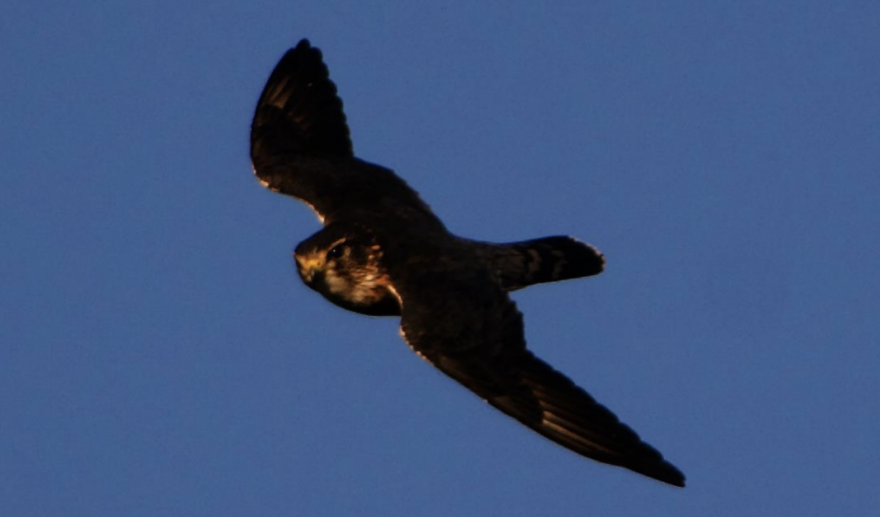
A Merlin cruising for a junco snack. (photo © Levi Burford)
– American Kestrel – 175 – a slightly above-average year for American Kestrels.
– Merlin – 130– the third-highest year in the history of the project.
– Peregrine Falcon – 44 – slightly above average.
Non-Raptor Highlights
2022 brought a diversity of birds to the Observatory, with a total of 96 non-raptor bird species were recorded. Highlights included our first count records for Baltimore Oriole and Red-throated Loon. One more special bird of the year was the observation on several days of a Boreal Chickadee. This marks the fifth season since 2005 that we’ve had a Boreal Chickadee at the Hawk Watch (sighted previously in 2005 and 2008).
It was also a light irruption year for finches and others, like a solitary Bohemian Waxwing.
532 Monarch butterflies were also tallied, far from any sort of record. The local drought in southern New Hampshire is suggested as a possible reason for the low migration numbers.
All bird data were entered into eBird.org and, like the raptor migration data, are available to scientific analysis as well as the general public. Raptor migration data are also available at hawkcount.org and are provided to the Raptor Population Index for long-term analyses and periodic raptor population trend estimates.
Thank You
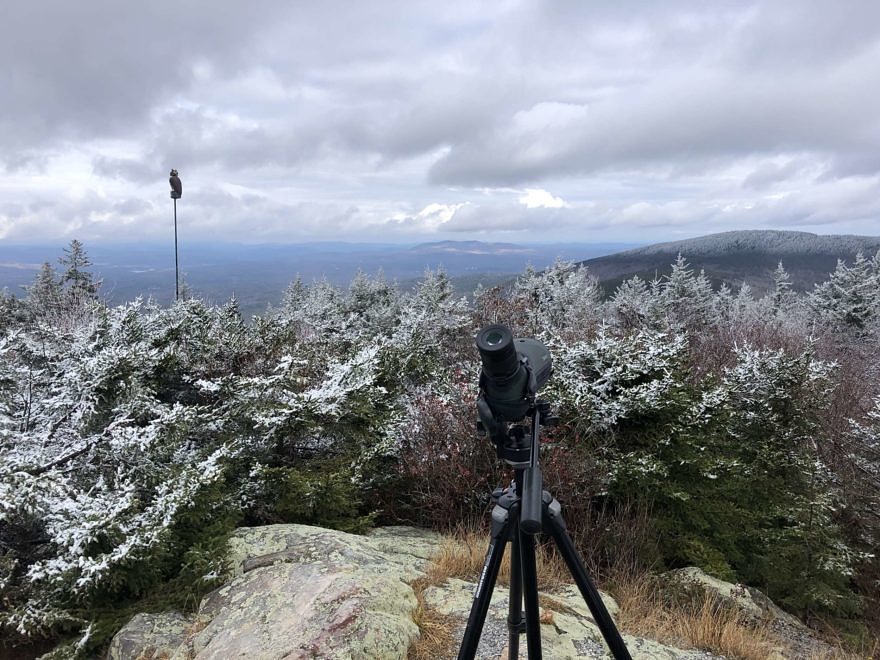
A dusting of snow at the Hawk Watch on November 15.
(photo © Julie Brown)
We thank you – our sustaining donors, partners, supporters, volunteers, observers, and readers – for following the migration with us this season, and for enabling us to continue our important dual mission of educating the visiting public about raptors and contributing vital data to international raptor population monitoring efforts.
A big thanks to Miller State Park and their staff for hosting us and making everyone feel welcome at the park, and special thanks to business partner Nature’s Green Grocer and the shoppers who have so generously contributed to the Pack Monadnock Raptor Observatory again this year through the store’s Green Giving Program. Continue to shop at the Green Grocer through the end of the month and contribute to the project!
For an in-depth season summary, check out our Annual Report, which provides an in-depth season summary, species analyses, a complete avian species list, and more. We look forward to seeing you again for more raptors in 2023!
12,000 Raptors & Counting…
On October 30, we surpassed the 12,000-raptor milestone for the season! We also recorded our highest season and daily totals for Red-shouldered Hawks. Rare Boreal Chickadee, Bohemian Waxwing, and Red-throated Loon have made appearances, and more Golden Eagles and Northern Goshawks will likely pass the summit in the coming weeks.
Though November is now here, it’s still a fine time to visit the Observatory, seek out the continuing migration, and marvel with and learn alongside our staff and volunteer team. Please keep in mind that Hawk Watch hours will switch to 9 a.m. to 3 p.m. starting on November 6, and that weather conditions may close the auto road to vehicles. Stay tuned to the Miller State Park website for any closure notices.
Lastly, it’s never too soon to express thanks to all the supporters, volunteers, staff, teachers, students, and other visitors who have contributed their time, funding, or energy to the Harris Center and the Observatory throughout the season — so thank you!
The Joys of October Hawkwatching
guest written by Will Stollsteimer, Harris Center Bird Conservation Intern
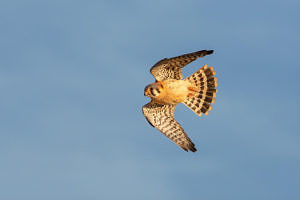
An American Kestrel in flight.
(photo © Josh Haas / Hawks on the Wing)
While September may be considered the premier hawkwatching month at Pack Monadnock, October offers spectacles of its own, including several variations on the theme of fall color. Early October is peak season for the most colorful raptor we see during migration — the American Kestrel, a small, charismatic falcon that can offer observers some fine looks as it cruises overhead. The middle of the month is of course highlighted by peak fall foliage. The Observatory platform is a wonderful place to view the changing season, as it overlooks expansive deciduous forests that display spectacular fall colors, in striking contrast to the evergreen spruce trees at the summit. Looking ahead, October often concludes with great viewing days for migrating Red-shouldered Hawks, with their rusty-red shoulders and chests. Come join us this October and enjoy the many different colors this month brings to Pack!
By the Numbers

A bar graph showing the total number of individual Broad-winged Hawks tallied from the Pack Monadnock Raptor Observatory each season from 2016 through 2022. Click on the graph for a larger view.
(graph by Will Stollsteimer)
During September, we observe the highest proportion of our seasonal migrants. How does this year stack up to others? With several days of light-to-moderate winds from the west, more migrating Broad-wings passed within sight of the platform and along the ridgeline this year, leading to an above-average flight of 9,368 individual Broad-winged Hawks (as tallied through early October). This surpasses the Observatory’s mean tally of 8,435 by nearly a thousand birds, and is our highest count for this species since 2016! Now, a little more than halfway through the season, we have already surpassed our annual season average of 11,210 migrating raptors (of all species). Can we break 12,000 before the season comes to a close in mid-November?
Some Unusual Visitors
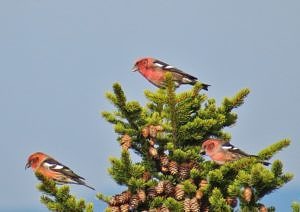
White-winged Crossbills sometimes make special appearances in the spruces at the Pack summit. (photo © Meade Cadot)
While September may host the highest number of migrating raptors, October presents an opportunity to catch some unusual visitors. This month can be very active for waterfowl migrating south in search of better foraging and warmer conditions. Canada Geese and Double-crested Cormorants are the most frequently encountered waterbirds at Pack. A keen eye may yield an opportunity to witness the migration of these species, and with luck, others like scoters and mergansers. With winter finch season just around the corner, this time of year can also bring the first trickles of boreal forest birds such as Pine Siskin, Red and White-winged Crossbills, Common Redpoll, and Evening Grosbeak. Come try your luck at searching for these less-frequent visitors to the platform!
Insight Into the Lives of Broad-winged Hawks
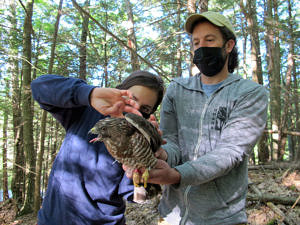
Dr. Rebecca McCabe of Hawk Mountain works with Harris Center Bird Conservation Director Phil Brown to attach a satellite transmitter to “Nubanusit,” a female Broad-winged Hawk nesting on Harris Center-conserved land, earlier this year. Visit Hawk Mountain’s BirdTracker map to see where Nubanusit is now!
(photo © Brett Amy Thelen)
On November 15, the Harris Center will welcome Dr. Rebecca McCabe, a research biologist from Hawk Mountain Sanctuary, for an exciting virtual presentation on the collaborative Broad-winged Hawk tracking research conducted by Hawk Mountain and the Harris Center. Dr. McCabe’s talk will focus on the breeding ecology of these raptors, as well as migration data from a group of Broad-wings that were tagged with satellite and cellular transmitters on SuperSanctuary land over the past two summers. (Now, a month after our big Broad-winged numbers have passed, many Broad-wings are nearing their wintering areas in South America. See where the Harris Center’s tagged Broad-winged Hawks are now via Hawk Mountain’s BirdTracker map.) If you’re looking for a more thorough understanding of the behavior of these raptors, we hope you’ll join us on November 15. You can learn more and register here.
Education at the Platform
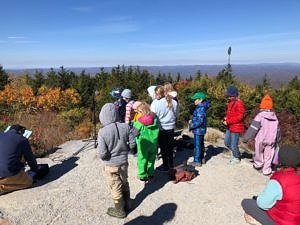
The Harris Center’s “At Home in Nature” homeschool group visits the Observatory — microphone in hand — on October 11.
(photo © Phil Brown)
One of the most important aspects of the Pack Monadnock Raptor Observatory is public outreach, and October has brought many students to the mountain — including the “At Home in Nature” homeschool group, led by Harris Center teacher-naturalist Ben King. During their October 11 visit, the homeschoolers hiked up the mountain and interviewed Phil Brown, Harris Center Bird Conservation Director and longtime Hawk Watch Coordinator, for a podcast about the wonders of the fall hawk migration.
Here at Pack, there will always be someone knowledgeable and willing to answer your questions and fascinations about raptor migration! Plan your visit now.
Broad-winged Hawks Steal the Show…
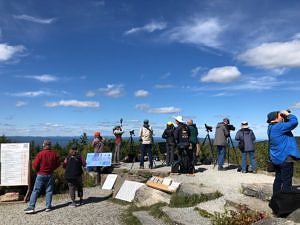
With 4,987 Broad-winged Hawks tallied, September 17 was the second biggest day in 18 seasons of monitoring of Pack.
(photo © Phil Brown)
Mid-September is always an exciting time at the Pack Monadnock Raptor Observatory. Over the past week, hundreds of hawk watchers, including several school groups, spent time at the Observatory. Many enjoyed a spectacular migration. The star of the September skies, as usual, was the Broad-winged Hawk, which gathers in huge ‘kettles’ during their annual fall migration to Central and South America.
Big Numbers
The flight that occurred at Pack on September 17 was rivaled by just one other in the 18-year history of the Observatory. At nearly 5,000 Broad-wingeds, we were just a few hundred hawks shy of the single-day record, set on September 18, 2011! After falling short all week of the really big numbers that Pack is known for in September, the skies opened up on Saturday, and Pack finally got its birds.
Raptor Release Day

Julie Brown holds an American Kestrel — one of five rehabilitated raptors released back to the wild at Pack Monadnock on September 18, 2022. (photo © James Newsom)
The day following the big flight was a much-awaited annual tradition: Raptor Release Day. In partnership with Wings of the Dawn Wildlife Rehabilitation Center, Harris Center staff and volunteers released five rehabilitated raptors back to the wild: two American Kestrels, two Broad-winged Hawks, and one Red-tailed Hawk. All were young birds that had been found either injured or unable to fly; Maria Colby of Wings of the Dawn rehabilitated each bird and ensured that they were strong and able to fly well before the release.
We were particularly delighted to welcome Steven Muzzey and his family of Loudon, who were in attendance to witness the release of the Red-tailed Hawk they found on a disc golf course in Pittsfield, NH.
Before their return to the wild, Harris Center naturalists and volunteers showed each bird on the glove, sharing natural history information with the rapt crowd. Several of the hawks gave long looks as they circled the summit and seemed to enjoy their newfound sense of freedom.
Hawks on the Move
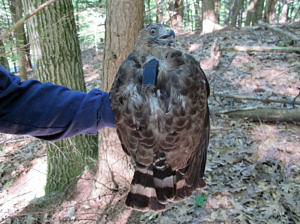
Nubanusit, sporting her new satellite transmitter in June 2022.
(photo © Brett Amy Thelen)
Four of the five Broad-winged Hawks tagged on their SuperSanctuary nesting grounds through the Harris Center’s project with Hawk Mountain Sanctuary have now checked in from various points along their migration routes. Thanks to the use of satellite and cellular transmitters, we can track the migration of these birds and determine precise information about their movements and habitat use. (One transmitter that was affixed last year seems to have failed or been removed, though the bird was seen on its breeding territory in the SuperSanctuary this past summer.)
“Nubanusit,” a female banded on Harris Center-conserved land in Antrim in late June, passed right over Hawk Mountain on September 15. “Skatutakee,” another female tagged in Dublin, passed over New York State on the same date. On September 18, both birds checked in near Monongahela National Forest in West Virginia. You can follow along with the movements of the tagged hawks via the “live map” link on Hawk Mountain’s “Meet the Bird” page.
What’s to Come: More Migration, of Course…
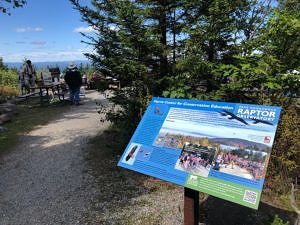
Visitors to the Pack Monadnock Raptor Observatory are greeted by a brand-new interpretive sign, designed by Margaret Baker of the Harris Center. (photo © Phil Brown)
We’ll be celebrating International Hawk Migration Week with our partner organization, the Hawk Migration Association of North America (HMANA), through the coming weekend.
In addition, late September into early October is peak migration time for the majority of the 15 or so raptor species that are detected annually at the Observatory. In the coming weeks, be on the lookout for peak numbers of Sharp-shinned Hawk, American Kestrel, Turkey Vulture, and Northern Harrier!
It Begins….
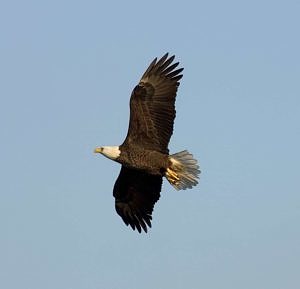
A Bald Eagle soars on updrafts through a blue September sky.
(photo © Lillian Stokes)
On September 1, we entered our 18th consecutive season of monitoring migrating raptors and educating visitors at the Pack Monadnock Raptor Observatory. The raptor flight has already begun, although somewhat slowly. Hot days followed by back-to-back washouts have spelled low numbers thus far, but we expect things to start turning around soon. Eleven species of migrating raptor have been recorded in our first week of monitoring, with Broad-winged Hawk, Sharp-shinned Hawk, Osprey, Bald Eagle, and Merlin leading the way. We also documented a rare Black Vulture, only the second record of this species whose range is expanding northward each year!
This season begins a new chapter as the Harris Center is now fully coordinating and running the Observatory. We thank NH Audubon for their long-term partnership and for their many years of steering this project, dating back to 2005 when Iain MacLeod officially founded the site.
Miller State Park and the NH Department of Natural and Cultural Resources remain our hosts and partners. As always, the Observatory relies on various funding sources, including private contributions – so thanks in advance for your continued support of this important conservation research and education project. While the Harris Center may now ‘fly alone,’ we have a strong team of staff, volunteers, partners, and community supporters who keep us aloft.

Levi Burford returns as our Seasonal Raptor Biologist and lead counter four days a week. (photo © Ben Conant)
In 2022, the Observatory welcomes back Levi Burford as Seasonal Raptor Biologist and lead counter four days per week (Thursday through Sunday). Volunteers Iain MacLeod (Mondays), Julie and Phil Brown (Tuesdays), and a combination of several other longtime observers (Wednesdays) will round out our lineup.
In addition, Harris Center teacher-naturalist Ben King will be on the summit many Wednesdays and Saturdays through late October, working with visiting school groups and weekend visitors. Educators from the SCA – NH Conservation Corps will also help us expand our reach. Will Stollsteimer, our first Bird Conservation Intern (and a student at Antioch University New England), will assist with the count once a week as he learns the ropes. Our team is assembled and ready in anticipation of the thousands of visitors and raptors we have come to expect at this Hawk Watch year after year.
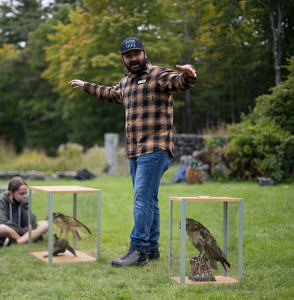
Harris Center teacher-naturalist Ben King will be on the summit many Wednesdays and Saturdays through late October, working with visiting school groups and weekend visitors. (photo © Ben Conant)
New signage and brochures will soon greet visitors upon arrival at the mountain. We’re gearing up for a couple of events – a Family Hawk Watch on September 10, the Big Sit on October 8, and possibly a low-key raptor release event (TBD). Otherwise, it will be business as usual, and we welcome all to come learn about the science and spectacle of migration with us!
The Observatory is staffed every day, weather permitting, from September 1 through November 20. While the Hawk Watch is free to visit, as always, reservations for Miller State Park are strongly recommended to guarantee your space on the mountain. Check out our Visiting the Hawk Watch page to plan your trip.
Contact Us
For more information on the Pack Monadnock Raptor Observatory or to volunteer, please contact Bird Conservation Director Phil Brown.
